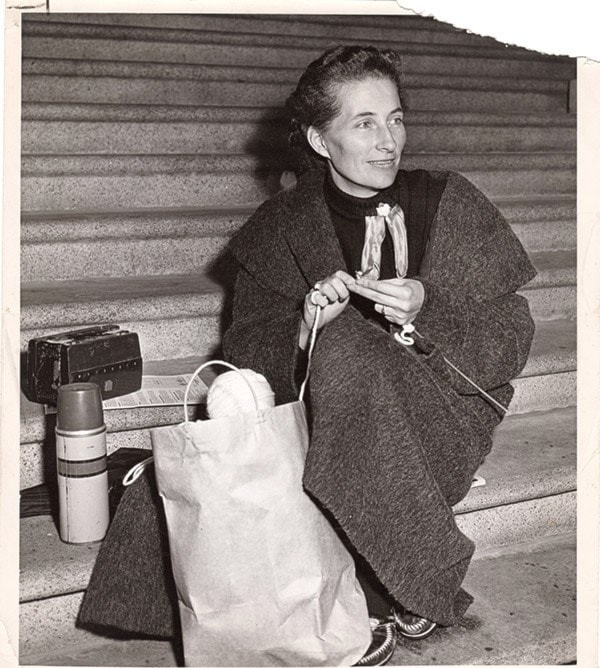A local resident who fought against the Worker’s Compensation Board (WCB) in the 1950s will be appearing in Working People: A History of Labour in British Columbia, a documentary appearing on Knowledge Network on April 3.Bea Zucco, who lives in Grand Forks with her daughter Sylvea, will be appearing in the third part of the three part series. After her husband contracted silicosis in 1955, a fatal lung disease, from working in mines in the West Kootenay/Boundary, Zucco took up the cause to get proper compensation for her, her husband and her four children.The story is told using archival images submitted to the producer, Landrock Entertainment, by Zucco herself.Zucco was born in Nelson and came over to Grand Forks where she lived up the North Fork for many years.Her husband, Jack, was a miner and they lived in mining camps.Zucco said she was contacted about a year ago by Erica Landrock, president and producer for Landrock Entertainment, about appearing in the documentary series.“My husband was in the mining business so we moved place to place,” said Zucco. “We were in Salmo when he got sick (with silicosis). When he got sick we were living in a mining camp and I was caring for three small kids.”She said because he had also had TB (tuberculosis), the government refused to acknowledge that he had Silicosis.Zucco said everytime she brought up a new doctor’s report stating Jack had silicosis, WCB would have another commission and turn them down.Zucco became well known in the media in those days for her battle when she resorted to steps such as sitting on the steps of the legislature in protest against the government and WCB. She also drove around the province in a “crusade car” donated by a dealership telling people about her battle.“They would say they dropped (the case), then I would go back and do something else,” she said. Jack died in 1958 before any final settlement was made. After his death, a pathologist found he had ‘advanced silicosis’ and eventually Bea and her children received proper compensation from WCB.“It was quite a process, but I had a lot of help,” she recalled. Back then, they had a silicosis pension but they would never award it, Zucco said. “Now, I’m very proud that if a miner gets silicosis he gets the pension. A lot of good things came out of it.”Her battles also led to better ventilation in mines. Zucco’s story has also been told on a CBC special and she appeared at the gallery 2 in February of last year as part of the living book series.Erica Landrock, who produced Working People: A History of Labour in British Columbia for the Knowledge Network, said using Zucco’s story for the series was an easy choice.“We had several researchers working on the project,” she said. “Her story came up as one potential one based on what happened with her and WCB. We ended up tracking down some great shots from the CBC about when she was on the steps of the legislature building doing her sit-down protest.”Since the series is all told through archival footage, Landrock and her researchers needed old photos and managed to track down Zucco.“I spoke with her about the project and whether she had any personal photos,” said Landrock. “She was very humble. I think she was amazed that we were interested in her story. It must’ve been quite a traumatic time in her life. She ended up entrusting us with her scrapbook which had all these articles written about her in the 50s as well as photos and her personal journal documenting that whole time. When I got the box (in Vancouver), I just said ‘yes, we have to do this story.’”Landrock said that Zucco’s story is the one that has touched her the most.“She’s really been an inspiration for me,” she said. “When most people watch the series and of the 30 stories we’ve done, they’ll say, ‘That Bea Zucco who fought the WCB what’s her story?’ She’s really made an impact on people.It was a tragic loss for her, said Landrock, but what’s fascinating is that throughout her campaign of when she was trying to get her husband’s pension, the B.C. government actually made legislative changes that would allow WCB to award Jack’s pension to Bea and her children.It wasn’t about just the money, said Landrock, “she wanted to make a difference for herself as well as for others going through the same problem.” Sidebars - Silicosis is a lung disease that is caused by inhaling tiny bits of silica. Silica is a common mineral that is part of sand, rock and mineral ores that quartz.People who work in jobs where they could breathe in these tiny silica bits—like sandblasting, mining, construction and many others—are at risk for silicosis. The silica dust can cause fluid buildup and scar tissue in the lungs that cuts down your ability to breathe. Silicosis cannot be cured.What is TB?Tuberculosis (TB) is a serious disease caused by a germ, a bacteria called Mycobacterium tuberculosis. TB usually infects the lungs. TB can also infect other parts of the body, including the kidneys, spine and brain.The main TB symptoms are a bad cough, fever, losing weight, and feeling weak.TB is contagious. People who are sick with active TB disease spread TB germs through the air. It's important for people with TB to get treatment right away. TB treatments can cure TB and prevent it from spreading to others.Source – American and Canadian Lung Association
